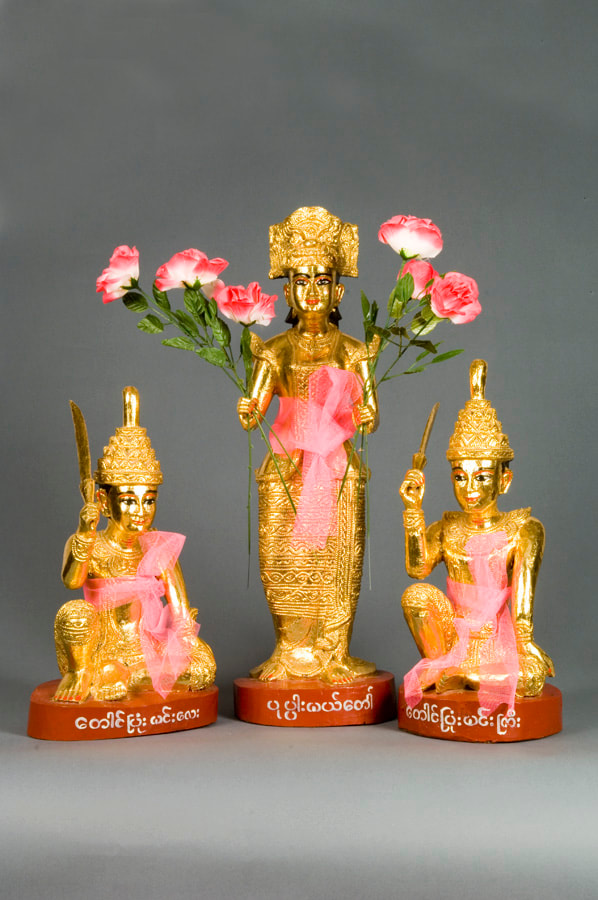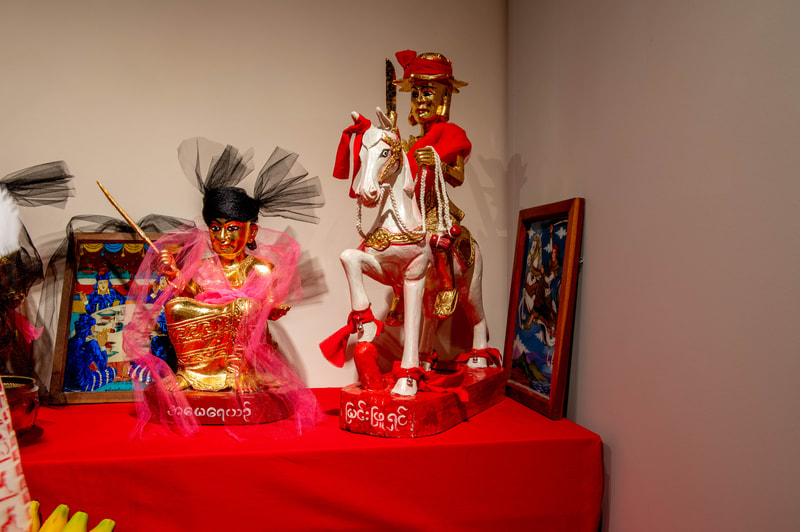Sept. 8, 2022 - May 13, 2023
part of Performing Southeast Asia
James B. and Rosalyn L. Pick Museum of Anthropology, NIU
|
Many Burmese believe that spirit beings called nat watch over the country from their shrines on the sacred Mount Popa located in the middle of the country.
There are many nat spirits, and each has a special place that they protect, including villages or individuals. Nats could inhabit trees, mountains, and other natural places. Amongst the numerous spirit nats there is an especially popular pantheon in Central Burma called “the 37 Lord Nats”, which were designated as an official pantheon in the eleventh century by King Anawrahta of Bagan. In this altar, only the 17 most popular are represented. |
Each nat has a name...
Each nat has a story...
Though originally a royal practice, today the ritual to the 37 nats constitutes an important part of popular Buddhist religious practice for many Burmese people. Nat festivals (nat pwe) are arranged for a variety of reasons, including to ask for protection, recovery from illness, a happy marriage, or a successful career or business. In March-April, August-September, and December, spirit mediums and devotees participate in nat pwe, where they celebrate and pay homage to the nats.
Each nat can come to life via nat pwe...
Communities in Burma participate in nat festivals (nat pwe) to receive protection or favorable fortunes from the nat spirits. Before a nat pwe begins, an offering consisting of banners, food, alcohol, and cigarettes/cigars is made to nat statues on an altar. A nat kadaw (spirit medium) leads the ceremony, singing, dancing, and reciting scenes from the life of particular nats being celebrated. A small, percussive Burmese orchestra called hsaing waing accompanies this performance. The nat kadaw falls into a trance and embodies the character of a particular nat while enacting their life. Acting as an intermediary between the nat and humans, the spirit medium provides specific offerings to the nat and receives protection for the community in return. The specialist of the ritual may also act as an oracle, reciting prophecies transmitted to them during their trance.
Nankarine was a special nat who was first a water buffalo...
|
Nankarine was a water buffalo who nurtured an orphan infant and was later killed by him when he became a king. She lives in the delta and eats fish and bananas. Her beautiful dance as represented on the watercolor depict her story as it is also figured on the glass painting. Over time, Nankayin’s representation changed from a buffalo to a woman with a buffalo headdress.
|
Nats in the Burma Art Collection at NIU
Gift of Dr. Catherine Raymond, 2006
Click on each large image to view additional angles for each sculpture.
17 nat sculptures
Amarapura (Burma/Myanmar)
2004
Lacquered wood, gold leaf, red and black paint
Gift of Catherine Raymond
(BC2006.04.01-17)
Amarapura (Burma/Myanmar)
2004
Lacquered wood, gold leaf, red and black paint
Gift of Catherine Raymond
(BC2006.04.01-17)
Other objects representing nats...
Acknowledgements
Curated by Dr. Catherine Raymond and Ma Sandar Wynn
Our gratitute to the students who contributed to the installation, photographing, text editing, and other aspects of the exhibition: Aung Htet Moe, Chloe Insley, Holly Young, Lay Mu, and Maeve Wallace.
Made in collaboration with the James B. and Rosalyn L. Pick Museum of Anthropology, NIU
Our gratitute to the students who contributed to the installation, photographing, text editing, and other aspects of the exhibition: Aung Htet Moe, Chloe Insley, Holly Young, Lay Mu, and Maeve Wallace.
Made in collaboration with the James B. and Rosalyn L. Pick Museum of Anthropology, NIU




















